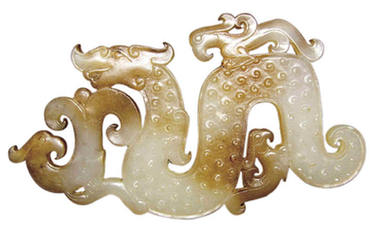| Fabulous Dragon Stone
By staff reporter Wu Bing
There is a Chinese saying, "Gold is expensive but jade is priceless." In other words, gold represents wealth and jade elegance. Gold inlaid with jade traditionally symbolizes happy marriage. This precious combination in the 2008 Beijing Olympic Games medal design conveys the host city's respect for the games and best wishes to Olympic athletes.
Depleted raw materials and rising market demand over past decades have sent jade prices sky-high. First-class Hotan white jade could be bought in the late 1970s for RMB 100 per kg. By 1995 this price had rocketed to RMB 6,000, and by 2000 soared to RMB 10,000. Its current price is RMB one million per kg. The upward trend in the jade market still continues. But this opulence is dwarfed by the even more precious Myanmar Jade, which sells at 10-100 times the price of white jade.
|
 |
|
A dragon made of Hotan Jade. |
Jade has been treasured in China for more than 7,000 years, and often features in historical legends. One, during the Spring and Autumn Period (770-476 BC), tells of a jade craftsman named Bian He from the State of Chu. One day he saw a phoenix perching on a rock. Convinced that this fabulous bird would stand only on the most precious of stones, he presented the rock to King Li of Chu. Royal craftsman, however, assessed it as nothing out of the ordinary. The angry king punished Bian He for what he construed as an attempt to fool him by having the craftsman's left foot cut off. When King Li died, Bian He once again presented the stone to the king's son and successor King Wu. But the new king's craftsman also deemed the stone commonplace, and Bian He lost his right foot as punishment. When King Wu died and his son succeeded the throne as King Wen, Bian He retreated to the foot of the mountain and cried for three days and nights, holding the stone. When the new king sent his attendant to find out why, Bian He told him, "I cry not because I have been crippled, but because jade is deemed stone, a loyal subject is adjudged a charlatan, and an innocent is humiliated." King Wen thereupon ordered that the stone be split open. The piece of perfect jade exposed at its heart was named He's Jade.
Many vassal states fought over the precious He's Jade, and the State of Zhao eventually won possession of it. The rising Qin kingdom, however, offered to trade 15 cities for the jade in 283 BC, and Zhao agreed, but mainly for fear of the Qin's overwhelming strength. "As worthy as a cluster of cities" hence became a common idiom.
Qin craftsmen carved an imperial seal out of the jade which the last Qin emperor presented to the conqueror Liu Bang, first emperor of the Han Dynasty (206 BC - AD 220). Amid the imperial infighting at the end of the Han Dynasty, a corner of the seal was broken. Craftsmen later mended it in gold, thus creating the craft of jade and gold inlay, the Beijing Olympics medal design.
The Five Virtues of Jade
There are around 100 types of stones that qualify as jade. According to Shuo Wen Jie Zi (Explanation and Study of Principles of Composition of Characters), the earliest Chinese dictionary compiled by Xu Shen during the Eastern Han Dynasty (25-220), "Jade, the beauty among stones, embodies five virtues." In other words, the only beautiful stones that may be called jade are those with five virtues. But criteria on which to judge whether or not a stone is beautiful, or beautiful enough to be called a jade, have changed with the development of society, production capacities, ideologies and aesthestic standards, and market demands. Stones formerly used for burning lime, laying roads or building houses now qualify as jade by virtue of their fine texture or historical background.
|
